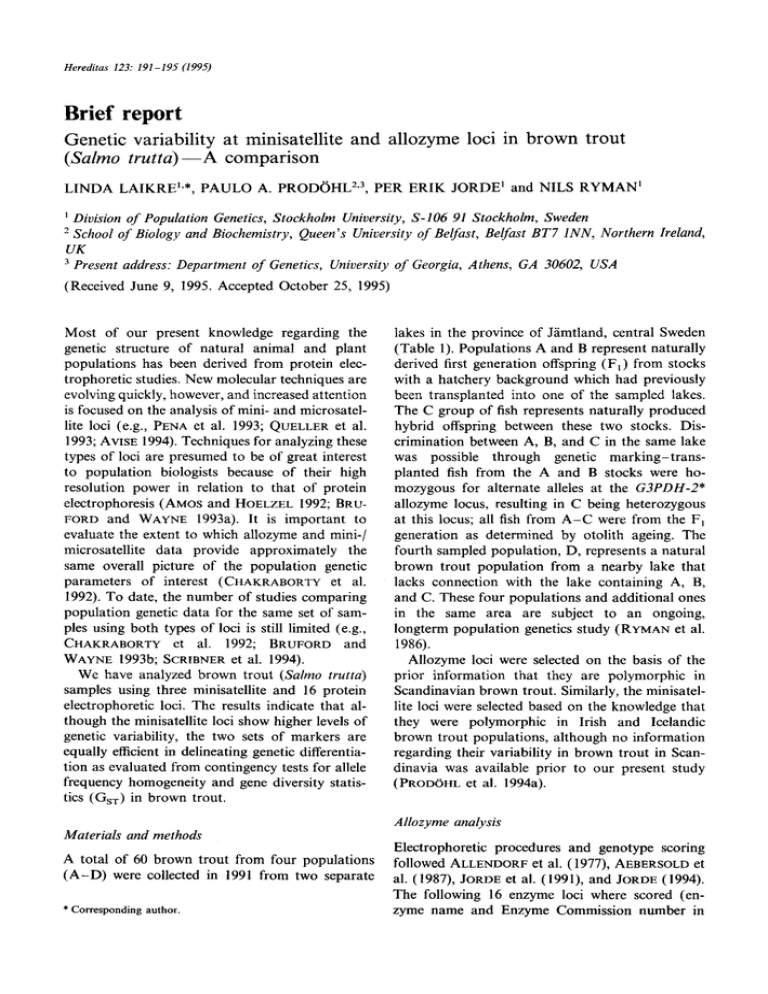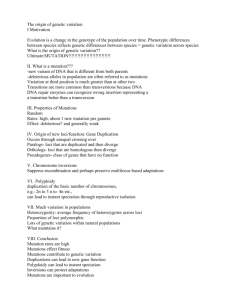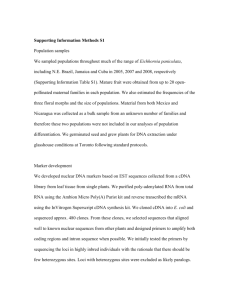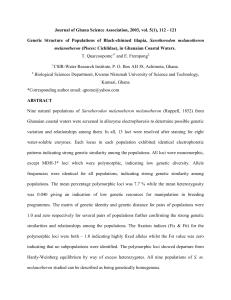Brief report (Salmo trutta) -A
advertisement

Hereditas 123: 191-195 (1995) Brief report Genetic variability at minisatellite and allozyme loci in brown trout (Salmo trutta) -A comparison LINDA LAIKRE',*, PAUL0 A. PRODOHL2.3, PER ERIK JORDE' and NILS RYMAN' Division of Population Genetics, Stockholm University, S - 106 91 Stockholm, Sweden School of Biology and Biochemistry, Queen's University of Belfast, Berfast BT7 INN, Northern Ireland, UK Present address: Department of Genetics, University of Georgia, Athens, GA 30602, USA I (Received June 9, 1995. Accepted October 25, 1995) Most of our present knowledge regarding the genetic structure of natural animal and plant populations has been derived from protein electrophoretic studies. New molecular techniques are evolving quickly, however, and increased attention is focused on the analysis of mini- and microsatellite loci (e.g., PENAet al. 1993; QUELLERet al. 1993; AVISE1994). Techniques for analyzing these types of loci are presumed to be of great interest to population biologists because of their high resolution power in relation to that of protein electrophoresis (AMOSand HOELZEL1992; BRUFORD and WAYNE 1993a). It is important to evaluate the extent to which allozyme and mini-/ microsatellite data provide approximately the same overall picture of the population genetic parameters of interest ( CHAKRABORTY et al. 1992). To date, the number of studies comparing population genetic data for the same set of samples using both types of loci is still limited (e.g., CHAKRABORTYet al. 1992; BRUFORD and WAYNE1993b; SCRIBNER et al. 1994). We have analyzed brown trout (Salmo trutta) samples using three minisatellite and 16 protein electrophoretic loci. The results indicate that although the minisatellite loci show higher levels of genetic variability, the two sets of markers are equally efficient in delineating genetic differentiation as evaluated from contingency tests for allele frequency homogeneity and gene diversity statistics (GST)in brown trout. lakes in the province of Jamtland, central Sweden (Table I). Populations A and B represent naturally derived first generation offspring (F,) from stocks with a hatchery background which had previously been transplanted into one of the sampled lakes. The C group of fish represents naturally produced hybrid offspring between these two stocks. Discrimination between A, B, and C in the same lake was possible through genetic marking-transplanted fish from the A and B stocks were homozygous for alternate alleles at the G3PDH-2* allozyme locus, resulting in C being heterozygous at this locus; all fish from A-C were from the F, generation as determined by otolith ageing. The fourth sampled population, D, represents a natural brown trout population from a nearby lake that lacks connection with the lake containing A, B, and C. These four populations and additional ones in the same area are subject to an ongoing, longterm population genetics study (RYMANet al. 1986). Allozyme loci were selected on the basis of the prior information that they are polymorphic in Scandinavian brown trout. Similarly, the minisatellite loci were selected based on the knowledge that they were polymorphic in Irish and Icelandic brown trout populations, although no information regarding their variability in brown trout in Scandinavia was available prior to our present study (PRODOHLet al. 1994a). Allozyme analysis Materials and methods A total of 60 brown trout from four populations (A-D) were collected in 1991 from two separate * Corresponding author. Electrophoretic procedures and genotype scoring followed ALLENDORF et al. (1977), AEBERSOLD et al. (1987), JORDEet al. (1991), and JORDE(1994). The following 16 enzyme loci where scored (enzyme name and Enzyme Commission number in 192 Hereditas I23 (1995) L. LAIKRE ET AL. Table 1. Summary measures of genetic variability at allozyme and minisatellite loci in brown trout from Sweden. ( H =expected heteroaygosity, P = percent polymorphic loci, A = average number of alleles per locus). X*-values refer to tests for allele frequency homogeneity among all four populations, summed over all variable loci Population A B C D Total Source Hatchery background Hatchery background Hybrid AxB Natural population Number of fish Allozyme data (16 loci) Minisatellite data (3 loci) H P Total number of alleles A 20 0.24 69 27 20 0.16 56 10 0.19 Number of unique genotypes H P 1.7 20 0.40 100 25 1.6 17 0.52 62 26 1.6 9 10 0.23 75 28 1.8 60 0.24 88 30 A Number of unique genotypes 8 2.7 13 100 8 2.7 14 0.44 100 7 2.3 7 10 0.66 100 14 4.1 10 1.9 55 0.59 100 16 5.3 39 G,, = 0.16 i0.04 x2 = 63.9, df = 9, P << 0.001 G, = 0.17 i- 0.05 x2 = 213.0, df = 39, P<<0.001 parentheses): sAA T-4* (aspartate aminotransferase, 2.6.1. l), CK-2* (creatine kinase, 2.7.3.2), DIA* (diaphorase, 1.6.2.2), bCALA -2* (P-Nacetylgalactosaminidase, 3.2.1.53), bCL UA * (Nacetyl-P-glucosaminidase, 3.2.1.30), IDDH- 1 * (L-iditol dehydrogenase, 1. I . 1.14), slDHP- 1 * (isocitrate dehydrogenase (NADP +), 1.1.1.42), LDH-l*,-5* (lactate dehydrogenase, I . 1.1.27), aMAN* (a-mannosidase, 3.2.1.24), sMDH-2*, -3,4* (malate dehydrogenase, 1.1.1.37), ME* (malic enzyme (NAD+), 1.1.1.39), MPZ* (mannose-6-phosphate isomerase, 5.3.1A), PEPLT* (leucyl-tyrosine peptidase, 3.4.-.-). In addition to these 16 loci, G3PDH-2* (glycerol-3-phosphate dehydrogenase, 1.1.1.8) was analyzed on fish from one of the lakes for discrimination between stocks A and B and their hybrid C, but this locus was excluded from subsequent statistical analyses. Total number of alleles been confirmed at these loci, and their characteristics have been described in detail by PRODOHL et al. (1994a, b, in prep.). Results and discussion None of the allozyme loci segregated for more than two alleles. Two of the 16 allozyme loci were monomorphic in all of the present populations, and the other 14 were polymorphic in one or more of the populations. A total of 7, 4, and 5 alleles were observed at the Str-AS, Str-A3, and SsaA45/ 1 minisatellite loci, respectively. The total amount of genetic variability observed at the allozyme loci is typical for that found at the loci examined in brown trout in Scandinavia (RYMAN 1983). To our knowledge, no previous data have been published on minisatellite variability in Scandinavian brown trout. Comparisons can be made, however, with the number of alleles found at Minisatellite analysis the same three minisatellite loci in Irish and IceTotal genomic DNA was isolated from muscle landic brown trout populations (PRODOHLet al. tissue following the simplified methodology of 1994a). The number of alleles observed in our TAGGARTet al. (1992). Standard protocols were present study is somewhat lower than that reported followed for gel electrophoresis (3 pg Pal I di- by PRODOHLet al. (1994a), but not markedly so. gested DNA per sample), Southern blotting (onto The difference is most likely due to the larger Hybond N membrane), and isotopic labelling of sample sizes of that study (cf. EWENS1979) and to probe (random priming). Prehybridization and hy- the hatchery background of populations A-C (see bridization conditions as well as posthybridization below). procedures followed those described by PRODOHL There are highly significant allele frequency hetet al. (1994a). erogeneities among populations at both sets of loci Three minisatellite loci were studied, Str-A3, (2 x 4 x2 contingency tests with pooling of alleles Str-AS, and Ssa-A45/1. Mendelian inheritance has into two classes at the minisatellite loci, accounting Herediras 123 (1995) for low expected values, and summing the x2 values yields P<<0.001 in both cases; Table 1). The amount of genetic variability observed at the two sets of loci is summarized in Table 1. The (expected) average heterozygosity, the proportion of polymorphic loci, and the average number of alleles per locus are all conspicuously higher for the minisatellite loci. The D population exhibits the generally highest level of genetic variation at both sets of loci (Table I). The lower amount of genetic variation in populations A-C is most likely a reflection of their recent hatchery backgrounds (hatchery propagation is frequently based on few parental fish). For the minisatellite loci the number of alleles is significantly higher in population D as compared to A, B, and C (Mann-Whitney rank sum statistics yields P < 0.05), but the difference is not significant at the allozyme loci. This observation is in accordance with the expectation that loci with many alleles lose more alleles during a population size bottleneck than loci with few alleles ( N E Iet al. 1975). The proportion of the total gene diversity attributable to differences between populations (G,,, NEI 1987) is almost identical for the two sets of loci (Table 1). In contrast, pairwise genetic identity values ( N E I 1972) range from 0.886 to 0.985 at isozyme loci and from 0.594 to 0.957 at minisatellite loci, which results in larger genetic distance values at minisatellite loci. These observations are consistent with a higher mutation rate at minisatellite loci, which affects genetic identity, whereas for selectively neutral alleles G,, is largely independent of the mutation rate and primarily represents a reflection of the population structure (CHAKRABORTY and LEIMAR1987; NEI 1987 and references therein). Our observations are somewhat different from those of SCRIBNER et al. (1994), who compared variability patterns in three populations of the common toad (Bufo hujb) for different sets of genetic markers including six allozyme and three minisatellite loci which were all polymorphic. For example, both the GSTvalues and their variances for the two sets of loci are very similar in our study (Table I ) , whereas SCRIBNER et al. (1994) report a considerably higher average F,, value (and variance) for the allozyme loci. Further, we found more unique multilocus genotypes at the allozyme than at the minisatellite loci (55 vs. 39; Table 1) whereas the opposite was observed by SCRIBNER et al. (1994). For the six most variable allozyme loci in our present study, the total number of multilo- BRIEF REPORT 193 cus genotypes is about the same as that observed at the three minisatellite loci (40 vs. 39). It is presently not clear if this discrepancy between the brown trout and the toad is due to a larger number of toads being analyzed (120 vs. 60 brown trout) or the greater number of polymorphic allozyme loci in our study (14 vs. 6). It must be emphasized, however, that the present study, as well as that of SCRIBNER et al. (1994), were based on very few minisatellite loci. In the present context it is of interest to compare the power of the two sets of loci for detection of population structuring as reflected by deviations from Hardy-Weinberg expectations. For this purpose we pooled the data from the 50 fish representing samples A-C, considering them a single sample from a single lake (which they are, but we have additional information about their background). On this pooled material we tested for deviations from Hardy-Weinberg expectations, applying an extended version of VITHAYASAI’S ( 1973) exact method ( LAGERCRANTZ and RYMAN 1990). We expect to find deviations from HardyWeinberg proportions (deficiency of heterozygotes) because of the significant genetic heterogeneity among these three stocks at both sets of loci (contingency x2 tests for allele frequency homogeneity yields P << 0.001 in both cases). For the allozyme loci, one of 1 1 tests showed a clearly significant deficiency of heterozygotes ( P = 0.003), whereas none of the three tests was significant for the minisatellite loci. In summary, it is obvious that the minisatellite loci exhibit a larger degree of genetic variability than the allozyme loci. However, in the present study there is no clear difference between the two sets of loci in the ability to detect and quantify genetic population structuring as revealed by contingency tests and G,, statistics. Both the time required to go from tissue sample to genotype and the cost for consumables are considerably higher for the minisatellites as compared to the allozymes. Taking all of these factors into account our results suggest that, for addressing questions relating to population structure, allozymes may be advantageous as compared to minisatellites for a species like the brown trout, for which a large number of variable allozyme loci have been identified. Mini- and microsatellites are currently fashionable within the field of population biology, but it appears that protein electrophoresis may in many cases still be a preferable tool (UTTER1991; AVISE 1994; PARKand MORAN1994; UTTER1994). It is 194 L LAIKRE ET AL. Heredims 123 (1995) obvious, however, that for species that require non-destructive sampling or those exhibiting low levels of protein electrophoretic variability, miniand microsatellite loci provide a valuable tool. Likewise, studies warranting a large number of alleles, such as problems relating to population bottlenecks, may benefit from mini- or microsatellite genotype data (MARTINSON et al. 1993; MENOTTIRAYMONand OBRIEN 1993). Clearly, it is ideal to analyze as many different types of genetic markers as possible, and reports of discrepancies between, for instance, allozyme and RFLP data (KARL and AVISE1992; POGSON et al. 1995) stress the need for further studies including both allozyme and various DNA marker data (ALLENDORF1994). Of course, the present study is small and therefore not generally conclusive. It is important, however, that results are reported so that, in combination with findings of other studies, they aid in providing information on the relationship between genetic markers reflecting different parts of the genome. Acknowledgements. -We thank Andrew Ferguson and John Taggart for valuable discussions and suggestions. The facilities made available to L. Laikre during a visit to the School of Biology' and Biochemistry, Queen's University of Belfast, Belfast, are gratefully acknowledged. The study was supported by a grant to N. Ryman from the Swedish Natural Science Research Council. The award of a Postgraduate Studentship to P. A. Prodohl by the Brazilian Federal Agency of Postgraduate Education (CAPES-No. 487/89-5) and a scholarship from Nilsson-Ehlefonden, Kungl. Fysiografiska Sallskapet i Lund to L. Laikre are greatly appreciated. References AEBERSOLD, P. B., WINANS,G. A,, TEEL,D. J., MILNER, G. B. and UTTER,F. M. 1987. Manual for Starch Gel Electrophoresis: A Method for the Detection of Genetic Variation.NOAA Technical Report NMFS 61 ALLENDORF, F. W. 1994. Comparative utility of genetic markers in the management of Pacific salmon: proteins, nuclear DNA, and mitochondria1 DNA. -In: Application of DNA Technology to the Management of Pacific Salmon (eds L. K. PARK,P. MORANand R. S. WAPLES),NOAA Technical Memorandum NMFS-N WFSC-I 7. Proceedings of the workshop, March 2223, 1993, Seattle, Washington. U S . Deparfment of Commerce, Nafional Oceanic and Atmospheric Administration, National Marine Fisheries Service, p. 127- 133 ALLENDORF, F. W., MITCHELL, N., RYMAN,N. and STAHL,G. 1977. Isozyme loci in brown trout (Salmo trutfa L.): detection and interpretation from population data. Heredifas 86: 179190 AMOS, B. and HOELZEL,R. 1992. Application of molecular genetic techniques to the conservation of small populations. Biol. Conserv. 61: 133-144 AVISE, J. C. 1994. Molecular Markers, Natural History and Evolution. - Chapman & Hall, New York and London BRUFORD,M. W. and WAYNE,R. K. 1993a. The use of molecular genetic techniques to address conservation questions. -In: Molecular Environmental Biology (ed. S . J. GARTE), Lewis Publishers, London, p. 1 1 -28 ~ ~ BRUFORD,M. W. and WAYNE,R. K. 1993b. Microsatellites and their application to population genetic studies. - Curr. Opin. Genet. Dev. 3: 939-943 CHAKRABORTY, R. and LEIMAR,0. 1987. Genetic variation within a subdivided population. In: Population Genefics and Fishery Management (eds N. R Y M . ~and N F. UTTER), Washingfon Sea Grant Publications/ University of Washingfon Press, Seattle and London, p. 89- I19 CHAKRABORTY, R., DEKA,R., JIN, L. and FERRELL, R. E. 1992. Allele sharing at six VNTR loci and genetic distances among three ethnically defined human populations. - Am. J. Hum. Biol. 4: 387-397 EWENS, W. J. 1979. Mathematical Population Genetics. Springer- Verlag, Berlin JORDE, P. E. 1994. Allozymes in Scandinavian brown trout (Salmo rrutra L.). - Report from the Division of Population Genetics, Stockholm University, Sfockholm JORDE,P. E., GITT, A. and RYMAN,N. 1991. New biochemical genetic markers in the brown trout (Salmo trutta L.). J. Fish. Biol. 39: 451 -454 KARL, S. A. and AVISE,J. C. 1992. Balancing setection at allozyme loci in oysters: implications from nuclear RFLPs. Science 256 100- 102 LAGERCRANTZ, U. and RYMAN,N. 1990. Genetic structure of Norway spruce (Picea abies): concordance of morphological and allozymic variation. - Euolufion 44: 38-53 MARTINSON, J. J., HARDING,R. M., PHILIPPON,G., FLYE SAINTE-MARIE, F., Roux, J., BOYCE,A. J. and CLEGG,J. B. 1993. Demographic reductions and genetic bottlenecks in humans: minisatellite allele distributions in Oceania. - Hum. Genet. 91: 445-450 MENOTTI-RAYMOND, M. and OBRIEN,S. 1993. Dating the genetic bottleneck of the African cheetah. - Proc. Nail. Acad. Sci. USA 90: 3172-3176 NEI, M. 1972. Genetic distance between populations. - Am. Nut. 106: 283-292 NEI, M. 1987. Molecular Evolutionary Genetics. - Columbia University Press, New York NEI, M., MARUYAMA, T. and CHAKRABORTY, R. 1975. The bottleneck effect and genetic variability in populations. - Evolution 29 1- 10 PARK,L. K. and MORAN,P. 1994. Developments in molecular genetic techniques in fisheries. -Rev. Fish Biol. Fish. 4: 272299 R., EPPLEN,J. T. and JEFFREYS, PENA,S. D. J., CHAKRABORTY, A. J. (eds). 1993. DNA Fingerprinting: State of the Science. Eirkhauser Verlag, Basel POGSON,G. H.,MESA, K. A. and BOUTILIER,R. G. 1995. Genetic population structure and gene flow in the Atlantic cod Gadus morhua: a comparison of allozyme and nuclear RFLP loci. - Genetics 139 375-385 PRODOHL,P. A,, TAGGART,J. B. and FERGUSON,A. 1994a. Single locus inheritance and joint segregation analysis of minisatellite (VNTR) DNA loci in brown trout (Salmo trutfa). Heredity 73: 556-566 PROD~HL P., A,, TAGGART,J. B. and FERGUSON,A. 1994b. Cloning of highly variable minisatellite DNA single-locus probes for brown trout (Salmo frutfa L.) from a phagemid library. - In: Genetics and Euolufion of Aquatic Organisms (ed. A. R. BEAUMONT),Chapman and Hall, London, p. 263-270 QUELLER, D. C., STRASSMANN, J. E. and HUGHES,C. R. 1993. Microsatellites and kinship. - Trends Ecol. Evol. 8: 285-288 RYMAN,N. 1983. Patterns of distribution of biochemical genetic variation in salmonids: differences between species. -Aquaculture 33: 1-21 RYMAN,N., OHMAN,R., STAHL, G., NILSSON,A,, LAGERCRANTZ, U. and HERLITZ, A. 1986. Genetisk variation hos laxartad fisk-en snabbt forsvinnande naturresurs: Information om genetisk forskning i Jamtland. (Genetic variation in salmonid fishes-a rapidly declining natural resource: Information on the scientific work in the Lakes Bavervattnen area in Jamtland, central Sweden. (In Swedish)). - Resta Grafska AE ~ ~ Heredims 123 (1995) BRIEF REPORT 195 SCRIBNER, K. T., ARNTZEN, J. W. and BURKE,T. 1994. ComparUTTER,F. M. 1991. Biochemical genetics and fishery manageative analysis of intra- and interpopulation genetic diversity in ment: an historical perspective. -J. Fish Biol. 39 [Supplemem Bufo bufo, using allozyme, single-locus microsatellite, minisatelA): 1-20 lite, and multilocus minisatellite data.- Mol. Biol. Euol. / I : UTTER, F. M. 1994. Perspectives of molecular genetics and 737-748 fisheries into the 21st century. - Rev. Fish Biol. Fish. 4: 374TAGGART,J. B., HYNES,R. A,, P R O D ~ H P. L , A. and FERGUSON, 378 A. 1992. A simplified protocol for routine total DNA isolation VITHAYASAI, C. 1973. Exact critical values of the Hardy-Weinberg test statistic for two alleles. - Comrnun. Sfat. I: 229-242 from salmonid fishes. -J. Fish Biol. 40: 963-965





